FOR UPDATED PHOTOS (implementation of swales early 2018, tree planting late 2018), SCROLL DOWN
Our vision of reforestation with agro-forestry design for the valley of Vilcabamba has taken a step forward with the contract to design and supervise implementation of a 17 hectare property, El Mirador, in barrio San Jose de Vilcabamba. In the video we made for our crowd-funding project, Water and a Forest for Every Village, we mention the need for more and larger models. This property is the beginning of our mid-size model. The project proposal can be seen here
MiradorDesignWEB
We are pushing the envelope on Permaculture standards for digging contour canals on steep slopes. When you collect water in any form, the effect of the water weight must be considered. Causing the land to de-stabilize is a concern.However, experience has shown that steeper drops within narrower canals can move the water safely off the mountain while accomplishing the aim of slowing the water down so it can penetrate the soil.
It is important to include an outlet when water is collected. We have used many "sills" in the project, which is a level cut in the down-hill side of the canal/swale wall. A sill creates a long spillway for the water to exit in a sheet. It can vary from one meter to several meters in length, depending on the scope of the project. In this project, because erosional breaks in the land are frequent, it makes it difficult to direct the water completely away from any erosion zone, before running into another. Thus, we used sills to spread the water out in zones that are less prone to erosion, and less steep.
FOR UPDATED PHOTOS, WITH CONTOUR CANALS & PONDS IN PLACE, SCROLL DOWN.
Narrow swales, with a slope within the swale of .3-.6 % to help rainwater in a strong storm move off the mountain safely without furthering erosion. The vetiver grass forms a barrier subteraneally and above ground. Roots grow 4-5m deep and form a thick web.
Saraguru crew with Zia. Don Ramon, in the white hat, is 70. He is still a powerhouse! Victor, on the right, is interviewed in our Water/ Forest video, he has taken our Permaculture Design Course twice, and is helping me supervise the crew.
POST-IMPLEMENTATION
This series of photos shows the infrastructure of the Water Retention Landscaping after implementation. The property had two areas of potentially severe erosion in two ravines. These photos show our treatment for the West ravine (quebrada). Our strategy was to measure contour canals leading away from the ravine, and to dig a water filtration pond with overflow to swales below it and a swale above it. There is a second, lower pond as a back-up overflow.
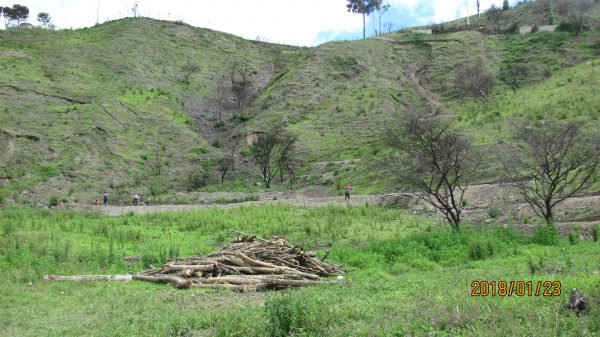 The main basin and main contour canal (swale) catching water coming out of the ravine.
The main basin and main contour canal (swale) catching water coming out of the ravine.
 These canals are directing water away from the upper part of the ravine, and also carrying water in the main swale to the lower overflow pond. You can see here the swale above the upper pond. Again the purpose is slowing and spreading the water, a precaution for not filling the pond too full, to avoid land slippage.
These canals are directing water away from the upper part of the ravine, and also carrying water in the main swale to the lower overflow pond. You can see here the swale above the upper pond. Again the purpose is slowing and spreading the water, a precaution for not filling the pond too full, to avoid land slippage.
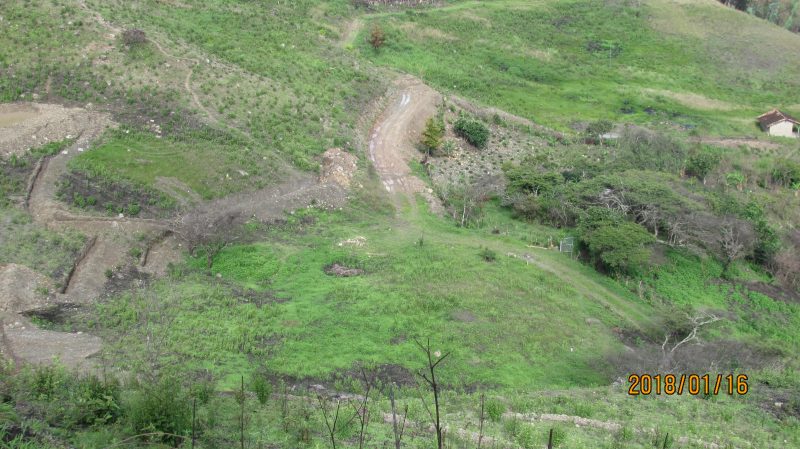 Here you can see the lower pond, which also has an overflow to a series of swales below it. We are aiming at spreading the water out to support grazing, and to minimize water volume in the main stream, which has massive erosion much lower in the village.
Here you can see the lower pond, which also has an overflow to a series of swales below it. We are aiming at spreading the water out to support grazing, and to minimize water volume in the main stream, which has massive erosion much lower in the village.
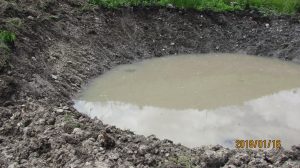 This is the lower pond, which filled immediately after creating it with an excavator.
This is the lower pond, which filled immediately after creating it with an excavator.
 This photo shows the main basin and contour canals, or swales and the connection with the lower swales and overflow systems. It also shows the degree of slope we were dealing with and famous Mandango mountain in the background.
This photo shows the main basin and contour canals, or swales and the connection with the lower swales and overflow systems. It also shows the degree of slope we were dealing with and famous Mandango mountain in the background.
 This shows the high swales on the East side. Again, we are directing water away from the quebrada, spreading it out to minimize it's erosive force in the lower ravine on the property, as well as lower down in the pueblo, where erosion has become severe to the point that it threatens houses.
This shows the high swales on the East side. Again, we are directing water away from the quebrada, spreading it out to minimize it's erosive force in the lower ravine on the property, as well as lower down in the pueblo, where erosion has become severe to the point that it threatens houses.
The Yupaichani Network supports tree planting on El Mirador property to assist mid-scale model.
In mid November 2018, we launched the Yupaichani Network, 5 projects that help the Earth and help the People! with a theatrical art auction & party! We raised enough money to go forward with tree planting El Mirador, our mid-scale model.
In November & December of 2018 we put our project Rehydrate<<>>Reforest “on the map” that is, making it known in Vilcabamba, with 1,100 trees planted on 5 properties. The Municipio of Loja donated 1,000 trees in 16 native species and Izhcailuma Hosteria donated another 100. El Mirador property, owned by James Williams, received 800 of these trees because it is located at the headwaters of the San Jose drainage and reforesting this land could help arrest serious erosion on that property that only gets worse downstream. It is also very visible when arriving in the valley from Loja. Thus, it is our “mid scale model.” When it comes down to it, the fact that James was willing to invest cash in making this happen was the ultimate deciding factor.
Few are willing to actually invest money in helping the Earth in practical ways, even though we are all threatened by eroding ecosystems. When the San Jose fire of late 2017 laid bare the extreme erosion on his land, James invested over $6,000 for planning & implementation of 800 m. of contour canals with precise slight slant away from the erosive ravines. This allows for rainwater penetration into the extremely steep slopes, providing support for trees to establish.
When Jamie’s budget for the project ran dry, the Yupaichani Network stepped in so we could go forward tree planting at the onset of the rains in November 2018. Our funds provided materials for over 120 grain sacks of compost we made, plus transportation for the volunteers of 6 mingas that planted the trees. Also, several workers were paid to help us complete the planting plan that I had provided for James.
Gracias! To all those who showed up for those mingas (volunteer community work parties). Some showed up for nearly every one, as I did, all on a totally on a volunteer basis.
In April, the owner, James Williams visited the land for the first time in 5 years. Roshni and I walked his land with him. Of the approximately 300 trees we checked that day, only 2 were not in good health. That is an extremely good survival rate. At that point, the rains were still coming steadily.
Next week, in late May, I will survey the land for survival rates again, with new volunteers that are coming. I have agreed to provide the municipio with reports on survival rates of the trees they donated on a quarterly basis for 5 years.
The Yupaichani Network contributed approximately $640 toward planting the 11,000 trees on 5 properties. The other properties were simply those that guaranteed planting on contour canals (swales) or terraces with irrigation. Thanks to Victor Macas, Walter Mora, Darina & Oracio and Bea for taking on the care of these trees! The Yupaichani Land Collective received $140. for installing a basic irrigation system for approximately 150 trees there. That will provide a basis for contrasting survival rates for swale systems vs. drip irrigation systems with dry season weekly watering and associated costs.
Costs:
Compost materials & labor-$85
Transport of 1,000 trees from Loja-$100
Transport volunteers & paid workers to planting sites--$105
Food for volunteers-$150
Paid workers for planting-$160
Total $600
NEEDS: Our 1,100 trees planted this year is clearly only a drop in the bucket, compared to the need. Yet it draws attention to the need and illustrates the desire and intention. It.gives a bit of a track record to help us get support from the various levels of government, and the international NGOs. And of course, Crowd Funding! Over 175 Crowd Funding Campaigns have earned over $1,000,000 each! Many of them are violent video games and movies. Help us tilt the balance toward caring for this beautiful planet!!! Please! Send a sincere, enthusiastic invitation to participate to your friends and families.
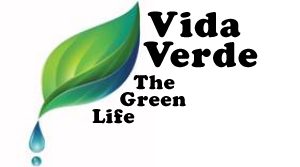




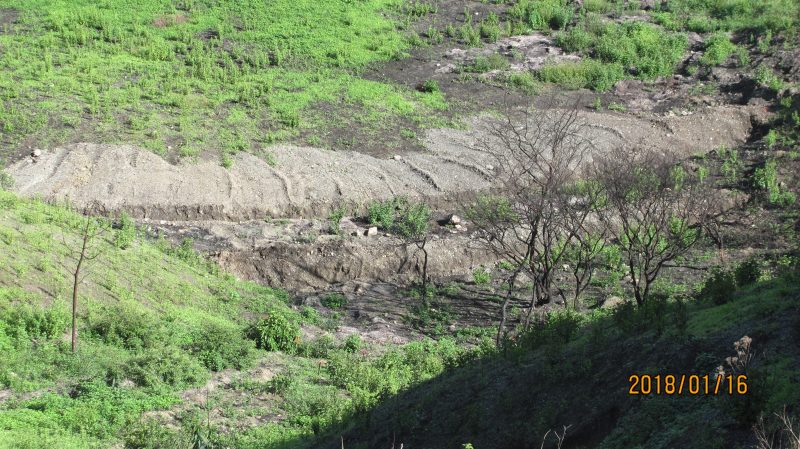








To Whom it may Concern,
I have owned a small finca in Vilcabamba for 15 years. In certain parts of this land there are areas of soil erosion and movement. In the need to fix this problem, about 8 years ago we put in large cement drain boxes with large pipes in order to prevent erosion worsening and a regular maintenance in these problem areas.
However, we still had earth movement and a problem with our underground spring, so after the recent large fire in 2017, it was apparent that we needed to do something new.
I knew of Zia and her school, so I asked her opinion about the land and I asked if she would be willing to walk the land, study it and come up with some plans or ideas.
She came up with a Permaculture design to stop the erosion. And begin educating me about the science of Permaculture. I spent many hours on YouTube watching videos about its science – a real eye-opening education. She said she could slow down the erosion and the earth movement in my water basin. We studied her Permaculture design and implemented the initial phase and it seem to have worked, especially in the critical areas. We hope to carry out the other parts of her plan next year when the rainy season starts. The bottom line is that her design costs less then me building expensive retaining walls, which would be unattractive and not fix the root of the problem.
Zia has a unique skill set and is very
knowledgeable and heartfelt and Permaculture is her passion. I would recommend her services.
Thanks for posting this comment Jamie. I really enjoyed this project. El Mirador is a beautiful spot. Since it is the headlands, that is,
the very beginning of the watershed that feeds the San Jose quebrada & neighborhood, El Mirador holds an important niche in the scheme of reforestation of Vilcabamba valley. I am very hopeful that we will be able to go forward with the planting trees at the onset of the next rainy season on the contour canals that have now been dug to stabilize the slope. That would give the reforestation “dream” a significant boost, and can potentially radically increase your production with multi-level cropping.
Thank you Jamie,it has been a pleasure.